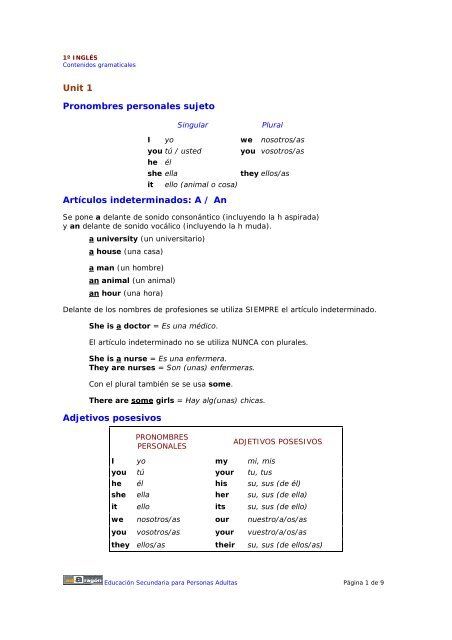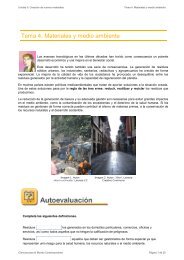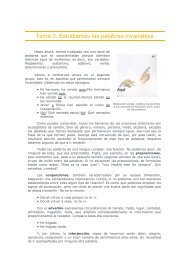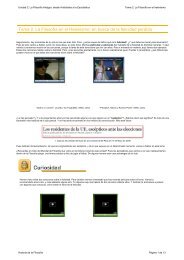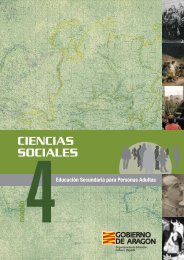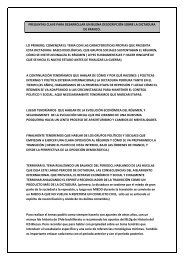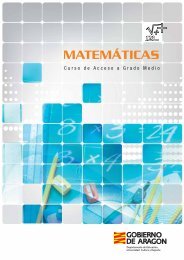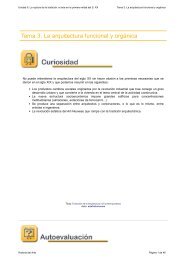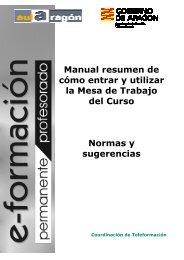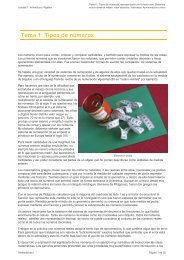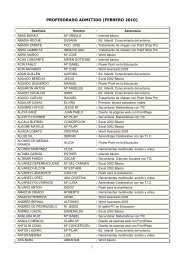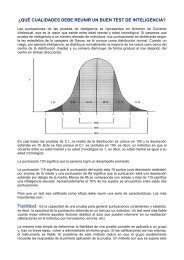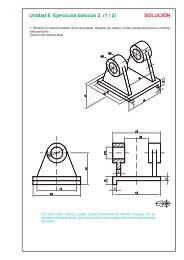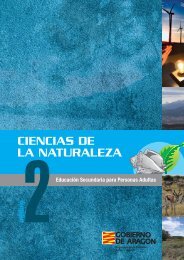A / An Adjetivos posesivos - aulAragon
A / An Adjetivos posesivos - aulAragon
A / An Adjetivos posesivos - aulAragon
Create successful ePaper yourself
Turn your PDF publications into a flip-book with our unique Google optimized e-Paper software.
1º INGLÉS<br />
Contenidos gramaticales<br />
Unit 1<br />
Pronombres personales sujeto<br />
Singular<br />
Plural<br />
I yo we nosotros/as<br />
you tú / usted<br />
you vosotros/as<br />
he él<br />
she ella<br />
they ellos/as<br />
it<br />
ello (animal o cosa)<br />
Artículos indeterminados: A / <strong>An</strong><br />
Se pone a delante de sonido consonántico (incluyendo la h aspirada)<br />
y an delante de sonido vocálico (incluyendo la h muda).<br />
a university (un universitario)<br />
a house (una casa)<br />
a man (un hombre)<br />
an animal (un animal)<br />
an hour (una hora)<br />
Delante de los nombres de profesiones se utiliza SIEMPRE el artículo indeterminado.<br />
She is a doctor = Es una médico.<br />
El artículo indeterminado no se utiliza NUNCA con plurales.<br />
She is a nurse = Es una enfermera.<br />
They are nurses = Son (unas) enfermeras.<br />
Con el plural también se se usa some.<br />
There are some girls = Hay alg(unas) chicas.<br />
<strong>Adjetivos</strong> <strong>posesivos</strong><br />
PRONOMBRES<br />
PERSONALES<br />
ADJETIVOS POSESIVOS<br />
I yo my mi, mis<br />
you tú your tu, tus<br />
he él his su, sus (de él)<br />
she ella her su, sus (de ella)<br />
it ello its su, sus (de ello)<br />
we nosotros/as our nuestro/a/os/as<br />
you vosotros/as your vuestro/a/os/as<br />
they ellos/as their su, sus (de ellos/as)<br />
Educación Secundaria para Personas Adultas Página 1 de 9
1º INGLÉS<br />
Contenidos gramaticales<br />
Presente del verbo TO BE<br />
AFIRMATIVA<br />
NEGATIVA<br />
Plena Contraída Plena Contraída<br />
I am I'm I am not I'm not<br />
you are you're you are not you're not<br />
he is he's he is not he's not<br />
she is she's she is not she's not<br />
it is it's it is not it's not<br />
we are we're we are not we're not<br />
you are you're you are not you're not<br />
they are they're they are not they're not<br />
INTERROGATIVA<br />
RESPUESTAS CORTAS<br />
Am I? Yes, I am No, I'm not<br />
Are you? Yes, you are No, you aren't<br />
Is he? Yes, he is No, he isn't<br />
Is she? Yes, she is No she isn't<br />
Is it? Yes, it is No, it isn't<br />
Are we? Yes, we are No, we aren't<br />
Are you? Yes, you are No, you aren't<br />
Are they? Yes, they are No, they aren't<br />
What ... ? / Where ... ?<br />
Estructura de las preguntas<br />
Interrogativo forma verbal sujeto preposición<br />
Where are you from?<br />
Preguntas utilizadas en la unidad<br />
What are you?<br />
What's your job?<br />
Para preguntar la profesión<br />
What's your name?<br />
Where are you from?<br />
Para preguntar el nombre<br />
Para preguntar la nacionalidad /<br />
lugar de nacimiento o procedencia<br />
What's your phone number? Para preguntar el teléfono<br />
What's your address?<br />
Para preguntar la dirección<br />
Educación Secundaria para Personas Adultas Página 2 de 9
1º INGLÉS<br />
Contenidos gramaticales<br />
Unit 2<br />
<strong>Adjetivos</strong> y pronombres demostrativos<br />
En inglés hay dos referencias de distancia (this / that)<br />
frente al español donde hay tres referencias de distancia (éste / ése / aquél).<br />
CERCA<br />
LEJOS<br />
This: éste, ésta, esto That: ése, ésa, eso, aquél, aquélla, aquello<br />
These: éstos, éstas Those: ésos, ésas, aquéllos, aquéllas<br />
Estos términos pueden ser tanto adjetivos (acompañan al sustantivo)<br />
como pronombres (lo sustituyen). Ejemplo:<br />
ADJETIVO This book is good Este libro es bueno<br />
PRONOMBRE This is a good book Éste es un buen libro<br />
Plural de los sustantivos<br />
REGLA GENERAL<br />
Se añade una s al singular<br />
girl<br />
friend<br />
Ejemplos<br />
girls<br />
friends<br />
EXCEPCIONES Singular Plural Casos particulares<br />
Terminados en s, ss, x, sh, ch<br />
añaden es<br />
Terminados en y<br />
(precedida de consonante)<br />
cambian y por i y añaden es<br />
a bus<br />
a glass<br />
a box<br />
a watch<br />
a country<br />
a baby<br />
a dictionary<br />
buses<br />
glasses<br />
boxes<br />
watches<br />
countries<br />
babies<br />
dictionaries<br />
¡Recuerda! y precedida de vocal añade<br />
una s (regla general)<br />
Ejemplos: a boy / boys a day / days<br />
Terminados en o<br />
añaden generalmente es<br />
a tomato<br />
a potato<br />
tomatoes<br />
potatoes<br />
A veces los terminados en o<br />
añade s (regla general)<br />
Ejemplos: radio / radios<br />
piano / pianos<br />
La mayoría de terminados en f<br />
o fe<br />
sustituyen la terminación por<br />
ves<br />
a wife<br />
a wolf<br />
a knife<br />
a shelf<br />
wives<br />
wolves<br />
knives<br />
shelves<br />
Excepción: roof / roofs<br />
(regla general)<br />
Sustantivos con plural<br />
irregular<br />
a man<br />
a woman<br />
a tooth<br />
a foot<br />
a child<br />
men<br />
women<br />
teeth<br />
feet<br />
children<br />
Educación Secundaria para Personas Adultas Página 3 de 9
1º INGLÉS<br />
Contenidos gramaticales<br />
Preposiciones<br />
IN dentro de The girl is in the phonebox<br />
ON sobre The girl is on the table<br />
AT junto a The girl is at the door<br />
AT<br />
en (lugares)<br />
The students are at school<br />
My brother is at the bank<br />
James is at the cinema<br />
UNDER debajo de The girl is under the table<br />
BEHIND detrás The girl is behind the sofa<br />
IN FRONT<br />
OF<br />
delante<br />
The girl is in front of de<br />
sofa<br />
OPPOSITE<br />
en frente de<br />
The bank is opposite the<br />
cinema<br />
NEAR<br />
cerca (de)<br />
The girl is near the<br />
telephone<br />
BETWEEN<br />
entre (dos cosas o<br />
personas)<br />
The girl is between the<br />
trees<br />
Educación Secundaria para Personas Adultas Página 4 de 9
1º INGLÉS<br />
Contenidos gramaticales<br />
Artículo determinado THE<br />
A) PRONUNCIACIÓN<br />
Delante de consonante Delante de vocal<br />
the<br />
sun<br />
moon<br />
cinema<br />
the<br />
artist<br />
armchair<br />
B) ES INVARIABLE. No tiene género, ni número.<br />
Corresponde en español a el, la, lo, los, las.<br />
C) OMISIÓN DEL ARTÍCULO. Se omite en los siguientes casos:<br />
En plural, cuando se habla en general<br />
Flowers are beautiful!<br />
En fórmulas o al hablar de algunos lugares<br />
públicos<br />
He's at school<br />
Mary's in hospital<br />
We're at home<br />
My mother is at work<br />
<strong>Adjetivos</strong> calificativos<br />
En inglés el adjetivo calificativo es siempre INVARIABLE, no tiene ni género, ni<br />
número.<br />
<br />
<br />
<br />
<br />
This man is old<br />
This woman is old<br />
These men are old<br />
These women are old<br />
COLOCACIÓN<br />
Puede ir colocado...<br />
Sólo, detrás del verbo<br />
Siempre delante del nombre:<br />
- Artículo + adjetivo + nombre<br />
- Adjetivo + nombre<br />
Ejemplo<br />
This man is old<br />
This is an old man<br />
These are old men<br />
EJEMPLOS<br />
DETRÁS DEL VERBO<br />
This woman is fat<br />
These men are old<br />
This car is small<br />
These trains are old<br />
DELANTE DEL NOMBRE<br />
This is a fat woman<br />
These are old men<br />
This is a small car<br />
These are old trains<br />
Educación Secundaria para Personas Adultas Página 5 de 9
1º INGLÉS<br />
Contenidos gramaticales<br />
Cualidades permanentes y estados transitorios<br />
Describen cualidades más o menos permanentes en<br />
una persona<br />
Describen estados transitorios de ánimo,<br />
enfermedad, etc.<br />
What are you like? ¿Cómo eres? How are you? ¿Cómo estás?<br />
How is<br />
What is he/she/it like? ¿Cómo es?<br />
¿Cómo está?<br />
he/she/it?<br />
What are they like? ¿Cómo son? How are they? ¿Cómo están?<br />
Ejemplo<br />
Ejemplo<br />
- What's that woman like?<br />
- She is tall and nice<br />
- What's your house like?<br />
- It's big and nice<br />
- ¿Cómo es esa mujer?<br />
- Es alta y agradable /<br />
simpática<br />
- ¿Cómo es tu casa?<br />
- Es grande y bonita<br />
- How is Jane?<br />
- She's ill<br />
- ¿Cómo está Jane?<br />
- Está enferma<br />
WH questions<br />
WHO ...?<br />
WHAT ...?<br />
Who's this?<br />
Who's that?<br />
Who are these?<br />
Who are those?<br />
What's this?<br />
What's that?<br />
What are these?<br />
What are those?<br />
Para identificar personas<br />
Para identificar objetos<br />
WHAT COLOUR<br />
...?<br />
WHAT ... TIME?<br />
WHERE ...?<br />
WHAT ... LIKE?<br />
HOW ...?<br />
HOW OLD ...?<br />
What colour is it?<br />
What colour are they?<br />
What time is it?<br />
What's the time?<br />
Where is he/she/it?<br />
Where are they?<br />
Where are you from?<br />
Para preguntar el color<br />
Para preguntar la hora<br />
Para localizar objetos o personas<br />
Para la nacionalidad o lugar de procedencia<br />
What is he/she/it like?<br />
Para describir objetos y personas<br />
What are they like?<br />
What's the weather like? Para preguntar sobre el tiempo atmosférico<br />
How is he/she?<br />
How are they?<br />
How old is he/she/it?<br />
How old are they?<br />
Para describir el estado actual de las<br />
personas<br />
Para preguntar la edad<br />
HOW FAR ...? How far is it? Para preguntar la distancia<br />
Educación Secundaria para Personas Adultas Página 6 de 9
1º INGLÉS<br />
Contenidos gramaticales<br />
Unit 3<br />
There is / there are<br />
Significado: there is (singular) y there are (plural) se traducen en castellano<br />
por hay (sólo tenemos una forma para el singular y el plural)<br />
There is an apple in the fridge. / Hay una manzana en el frigorífico.<br />
There are three apples in the fridge. / Hay tres manzanas en el frigorífico.<br />
Afirmativa: there is (singular) / there are (plural)<br />
There is an apple in the fridge.<br />
There are three apples in the fridge.<br />
Negativa: there is not / there isn't (singular) y there are not / there aren't<br />
(plural)<br />
There isn't an apple in the fridge.<br />
There aren't three apples in the fridge.<br />
Interrogativa: Is there ... ? (singular) / Are there ... ? (plural)<br />
Is there an apple in the fridge?<br />
Are there three apples in the fridge?<br />
Respuestas cortas en afirmativa: Yes, there is (singular) / Yes, there are<br />
(plural)<br />
Is there an apple in the fridge? Yes, there is.<br />
Are there three apples in the fridge? Yes, there are.<br />
Respuestas cortas en negativa: No, there isn't (singular) / No, there aren't<br />
(plural)<br />
Is there an apple in the fridge? No, there isn't.<br />
Are there any apples in the fridge? No, there aren't.<br />
HAVE GOT (presente)<br />
Forma afirmativa<br />
FORMA PLENA<br />
I have got<br />
You have got<br />
He has got<br />
She has got<br />
It has got<br />
We have got<br />
You have got<br />
They have got<br />
FORMA CONTRACTA<br />
I've got<br />
You've got<br />
He's got<br />
She's got<br />
It's got<br />
We've got<br />
You've got<br />
They've got<br />
Educación Secundaria para Personas Adultas Página 7 de 9
1º INGLÉS<br />
Contenidos gramaticales<br />
Forma negativa<br />
FORMA PLENA<br />
I have not got<br />
You have not got<br />
He has not got<br />
She has not got<br />
It has not got<br />
We have not got<br />
You have not got<br />
They have not got<br />
FORMA CONTRACTA<br />
I haven't got<br />
You haven't got<br />
He hasn't got<br />
She hasn't got<br />
It hasn't got<br />
We haven't got<br />
You haven't got<br />
They haven't got<br />
Forma interrogativa<br />
Have I got?<br />
Have you got?<br />
Has he got?<br />
Has she got?<br />
Has it got?<br />
Have we got?<br />
Have you got?<br />
Have they got?<br />
Nombres contables e incontables<br />
Nombres contables<br />
Se consideran como unidades que se pueden contar: one apple, two apples, three<br />
apples...<br />
Tienen forma singular o plural.<br />
Con el SINGULAR se usa a / an: a table, an apple.<br />
Con el PLURAL se usa some (unos o algunos en castellano): some apples, some<br />
books.<br />
Nombres incontables<br />
No se pueden contar: water, bread, money...<br />
Sólo tienen SINGULAR.<br />
Suelen ir precedidos de some (con el significado 'de algo de' en castellano): There is<br />
some water in the glass.<br />
Se pueden cuantificar estos nombres utilizando otras palabras: a glass of water, a loaf<br />
of bread...<br />
Educación Secundaria para Personas Adultas Página 8 de 9
1º INGLÉS<br />
Contenidos gramaticales<br />
SOME / ANY<br />
Some<br />
Se emplea en frases AFIRMATIVAS con nombres CONTABLES EN PLURAL (con el<br />
significado de 'algunos/as'): She has got some apples.<br />
Se emplea en frases AFIRMATIVAS con nombres INCONTABLES EN SINGULAR (con el<br />
significado de 'algo de'): There is some water in the glass.<br />
<strong>An</strong>y<br />
Se emplea en frases NEGATIVAS con nombres CONTABLES EN PLURAL (con el<br />
significado de 'ningún/ninguna') e INCONTABLES EN SINGULAR (con el significado de<br />
'nada de'): There aren't any apples in the fridge. / There isn't any water in the glass.<br />
Se emplea en frases INTERROGATIVAS con nombres CONTABLES EN PLURAL (con el<br />
significado de 'algún/alguna') e INCONTABLES EN SINGULAR (con el significado de<br />
'algo de'): Are there any apples in the fridge? / Is there any water in the glass?<br />
HOW MUCH / HOW MANY<br />
How much<br />
Se usa para preguntar por la cantidad de algo incontable, en SINGULAR, aunque la<br />
respuesta se dé en plural, caso muy corriente cuando el valor de algo<br />
Ejemplos:<br />
How much money have you got? (SINGULAR)<br />
I've got 50 p. (PLURAL)<br />
Otras posibles respuestas:<br />
I've got some.<br />
I haven't got any.<br />
How much milk is there in the fridge? (SINGULAR)<br />
There is some milk. (SINGULAR)<br />
Money es incontable, por lo tanto, el verbo debe ir en singular, pero la respuesta<br />
puede ir en plural.<br />
How much money is there?<br />
There are 20 euros.<br />
How many<br />
Se usa para preguntar por la cantidad de algo contable en PLURAL.<br />
How many apples are there in the fridge?<br />
There are 5 apples.<br />
Otras posibles respuestas:<br />
There are some.<br />
There aren't any.<br />
People en inglés es siempre PLURAL; en cambio, en castellano es singular. Por tanto,<br />
se pregunta How many people are there?<br />
Educación Secundaria para Personas Adultas Página 9 de 9


